
Although it’s not possible to call the new Samsung 970 EVO a top-end consumer SSD, but thanks to its latest 3D TLC NAND flash memory and its own SSD controller, the 970 EVO offers almost all the characteristics of its colleagues with the PRO code prefix in the title, but for clearly smaller money.
- Phoenix rises
- AnandTech Drive Test - The Destroyer
- Test drives AnandTech - Heavy
- Test drives AnandTech - Light
- Random read test
- Sequential read performance
- Mixed random performance
- Power management
- Measurement of power at idle
- In conclusion
Phoenix rises
Samsung has announced the release of two new SSD stacks: 970 EVO and 970 PRO. The new Samsung 970 EVO is in fact a popular TLC version of the new generation of custom NVMe SSD, and the 970 PRO is built using MLC NAND flash memory. From our point of view, affordable for almost every pocket of 970 EVO can rightly be considered a more interesting product of the company.
In principle, the vector for the development direction of the 970 EVO could have been guessed from the Samsung PM981 presented for OEMs a couple of months ago. It was clear that the replacement for the 960 EVO will come in a drive, in which the 48-layer 3D-TLC is replaced with 64-layer TLC, and the Samsung Polaris controller - with the Phoenix controller. During testing of PM981 (last November), this combination broke all records set by the 960 PRO, so we were looking forward to the appearance of the 970 EVO.
Samsung did not discover all the details of the new Phoenix controller architecture, but, like its earlier NVMe controllers, the controller is equipped with a PCIe 3.0 x4 interface and includes 8 channels for accessing NAND flash memory. Like the Polaris controller, Phoenix combines five cores with the ARM architecture at once, and one of them is allocated exclusively for work with the host. As you know, the controller provides very high performance and is used in the top line of corporate SSDs - Z-SSD SZ985. The performance of the Samsung 3D TLC NAND is lower than that of the Z-NAND, but not because of the bottlenecks of the controller itself. The 970 EVO supports some of the latest features of the NVMe 1.3 specification, it is designed to meet all expectations and be among the top league SSD.
Many SSD manufacturers have abandoned the use of MLC NAND in their SSD lines in favor of switching to 64-layer 3D-NAND. It turns out that the Samsung 970 PRO will compete with only a handful of similar products, and the 970 EVO will be able to withstand the flagship SSD of most branded manufacturers. In addition, the flagship products of the 970 EVO will also comply with the provision of a 5-year warranty and a 50% increase in endurance. Well, roofing felts are a significant blow, roofing felts are a pleasant surprise for all those who follow the “development” of Samsung EVO drives.

Samsung 970 EVO - is a wide range of drives, ranging from a capacity of 250 GB to 2 TB. 2 TB of free space will be released only for the cheaper version of the EVO TLC drive, but not for the PRO lineup. This model with a capacity of 2 TB will become the only model of the 970 EVO, where 512-gigabit TLC crystals with 64-layer organization will be used, and 256-gigabit ones in smaller capacity drives. The increase in the volume of cores used by the TLC 3D V-NAND reduces the degree of parallelism, therefore less capacious drives benefit from it.
512-gigabit crystals allow Samsung to easily place 2 TB of flash memory on a one-way motherboard form factor M.2 2280, bypassing the expensive DRAM. Recall that earlier Samsung reached the two-byte boundary due to two factors: the transfer to the third-generation two-bit V-NAND with a capacity of 256 Gbps crystals and the ability to stack up to sixteen such crystals in one chip.
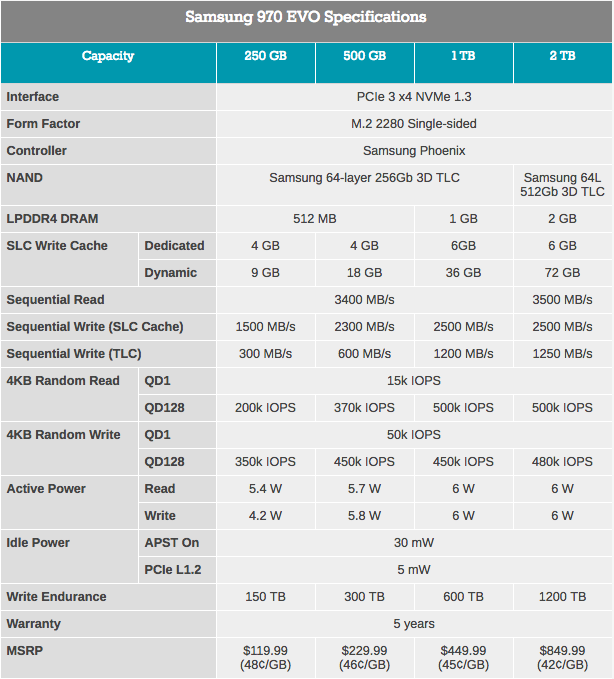
The Samsung Phoenix controller is covered with a heat-distribution copper plate with a nickel-coated, at 970 EVO a layer of copper foil is on the label on the rear panel of the drive, this solution was presented as early as 960 generation; that's all cooling measures. Samsung claims that the 970 has an increased thermal ceiling for throttling.

970 EVO and 970 PRO will go on sale from May 7, 2018.
In this review, the 500 GB and 1 TB Samsung 970 EVO will enter the battle with:
- 960 EVO and 960 PRO, the previous generation of high-quality SSD-drives from Samsung NVMe.
- PM981, OEM SSD, with the same controller as the 970 EVO. PM981 as a separate drive is not officially available for retail, but OEM manufacturers have been shipping for several months.
- Western Digital WD Black 3D NAND, the first drive with a new NVMe integrated SSD controller from WDC and with its own NVMe 3D-NAND SSD drive.
- Intel SSD 760p, NVMe SSD of the middle class, with the SM2262 controller from Silicon Motion and 64-layer 3D-TLC from Intel.
In addition, participation in testing will take a couple of "older" SSD-drives NVMe, some SATA, and Intel Optade SSD 900P - ultra-premium class drive from Intel. The Samsung 970 PRO will also be tested soon, and is also included in this review.

Thanks for the help in conducting the tests:
- Intel Xeon E3 1240 v5 processor
- ASRock - E3V5 Performance Gaming / OC motherboard.
- G.SKILL - DDR4-2400 RAM.
- Corsair - RM750 power supply, Carbide 200R package, water-cooled for the Hydro H60 processor.
- Quarch - XLC programmable power supply and accessories.
- StarTech - RK2236BKF 22U rack.
AnandTech Drive Test - The Destroyer
The Destroyer is an extremely time-consuming test that shows how an SSD behaves with intensive workloads with a large amount of I / O. The Destroyer has been an integral part of the Anandtech test suite for almost two years, it is designed to “destroy all greenhouse conditions” by loading the system in SSD searches with the best performance characteristics. As in the real world, the drives were given time to take a breather in order to clear the collection of garbage from them and clean the cache, only idle periods were reduced to 25 ms, and therefore we did not get the results a week later. The AnandTech Storage Bench (ATSB) tests do not include the launch of real applications that generate workloads, so the performance will not change much with changes in CPU and RAM performance, but the transition to a newer version of Windows and the latest drivers may affect the “picture” test.
The performance evaluation of this test depends on the average throughput of the drive, the average latency of I / O operations, and the total energy consumed by the drive during the test.
The blue lines are PM981, OEM version 970 EVO.
Orange lines - 970 EVO.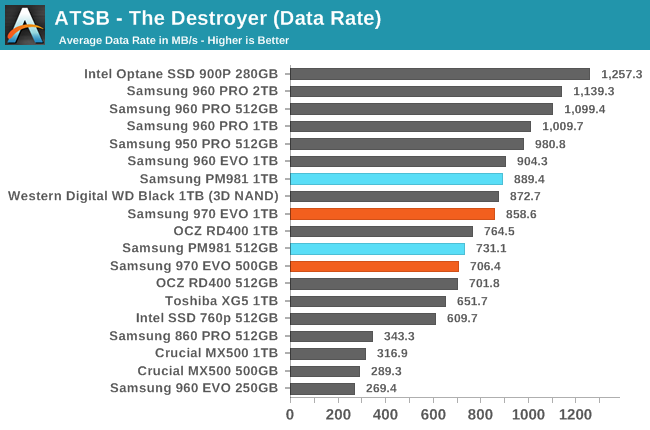
The average data transfer rates of the Samsung 970 EVO at The Destroyer are not as good as the Samsung PM981 OEM drive, as well as the 960 EVO drive. All TLC drives are located lower than the earlier NVMe drives from Samsung on the basis of MLC. The undisputed leader is Intel Optane SSD. As for Western Digital WD Black, it offers approximately the same performance as the 970 EVO.
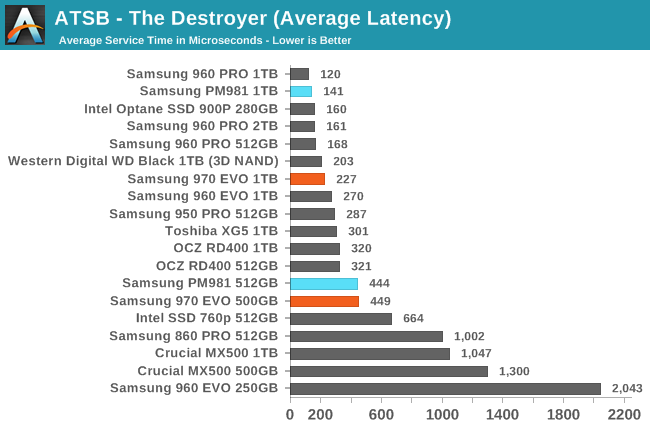

According to the results of the average delay and p99 (99th percentile), the delay of 970 EVO is not much worse than PM981, but with such indicators it surpasses its predecessor 960 EVO. WD Black showed a very good average delay and p99.
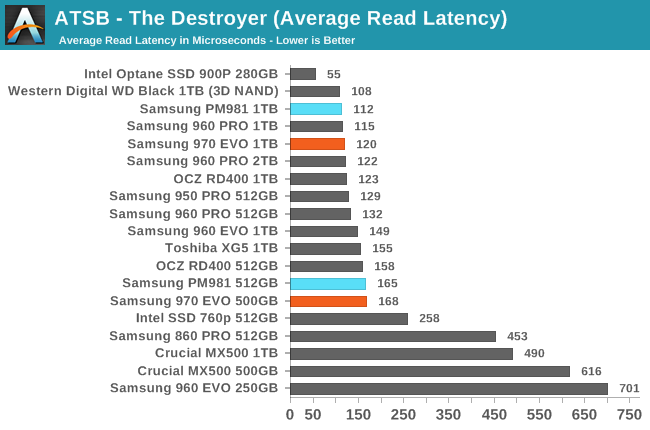

There is a well-defined range of average read latency that defines the high-end NVMe market segment. 970 EVO does not stand out among other drives in this category. Indicators of the average recording delay change the picture, although the 970 EVO slightly surpasses its predecessor, but still falls short of the PM981 results.

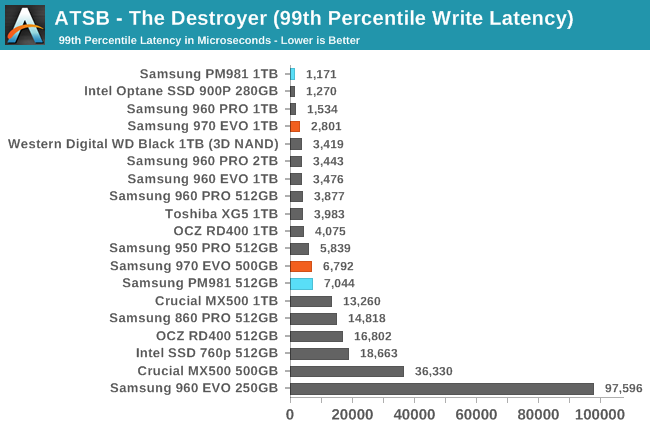
According to estimates of the 99th percentile read and write delays, the 970 EVO is again below PM981, but not so much as to speak about any serious problem. WD Black is the only flash SSD with a read delay of less than 1 ms.
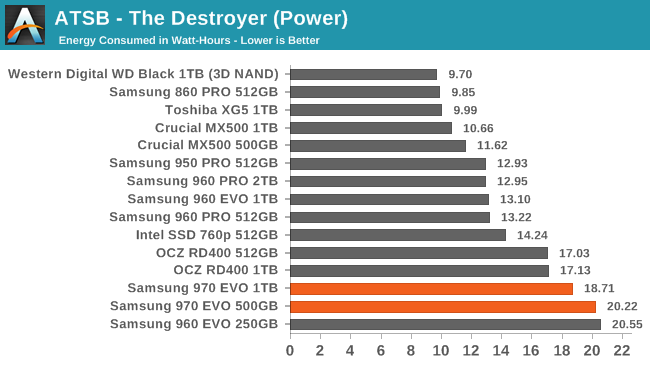
Before that, we had no way to measure the power consumption of the Samsung PM981 during “The Destroyer”, so this is our debut in testing the power consumption of the Samsung Phoenix controller. The situation is not the best: the 970 EVO consumes twice as much energy as the WD Black, despite the fact that both drives show approximately the same level of performance during testing "The Destroyer". In terms of energy efficiency, the 970 EVO does not stand up to the competition.
Test drives AnandTech - Heavy
Our test "Heavy", unlike the "Destroyer", is designed to demonstrate the operation of SSD under heavy loads, but unlike the previous one, it does not take much time. The total amount of recorded data during the Heavy test will not fill the disk, which will not bring the SSD to a steady state; The test results are significantly affected by the performance of the drive during peak periods. Detailed data on the Heavy test can be found in the corresponding article on AnandTech. This test is run twice, once on a completely cleaned drive, and once after filling the drive with a long write.
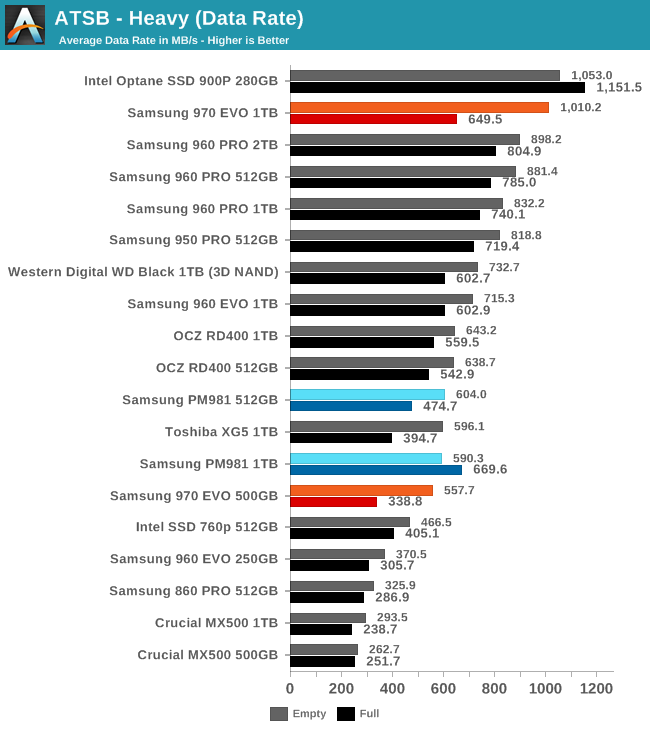
During the first runs of the Heavy test, the Samsung 970 EVO showed similar results with the Samsung PM981, and the 1 TB model showed worse performance on an empty disk than on a full drive. This is similar to the process of deleting information in Secure Erase mode before testing. Like many discs, the 970 EVO, it seems to be “lying” about the end time of cleaning. Adding an additional 10 minutes of idle time before running the Heavy test allowed us to get the results shown here for the future - all drives will be tested with longer pauses after cleaning (the test on all other disks was started at least two minutes after inactivity after each cleaning).
If you do not take into account this "strange behavior", the Samsung 970 EVO is close to setting a record for the Heavy test results. The performance of an empty drive model with a capacity of 1 TB is higher than Optane, although the average data transfer rate on the drive is not much higher than that of other TLC drives. The 500 GB model is much slower, and its performance in full condition is not far from the Intel SSD 760p performance.


Well, the average delay and p99 Samsung 970 EVO correspond to those of competitors, with the exception of a very good result on an empty 1TB 970 EVO drive.
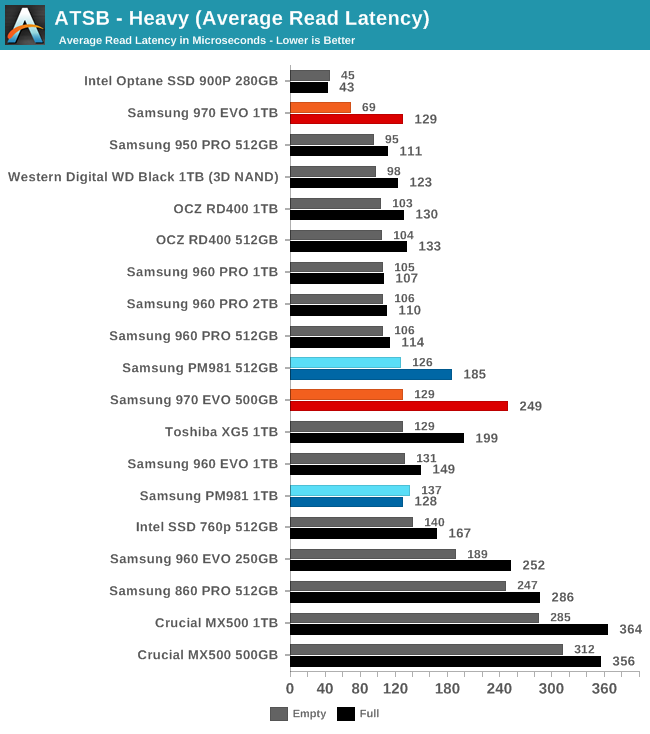
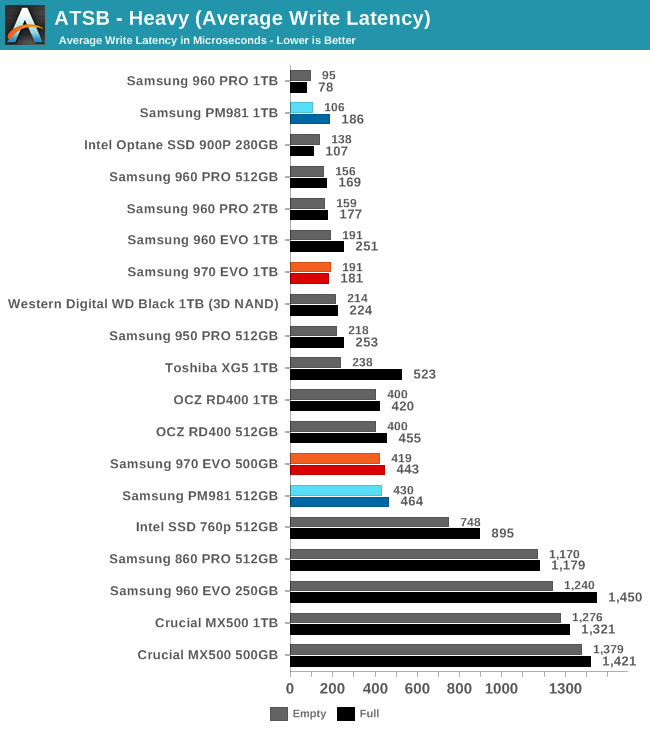
The average write latency of the 970 EVO is characterized by high-end NVMe SSDs, but the average read latency of the 970 EVO with a capacity of 1TB is surprisingly short. In both drives of different capacity (500 GB and 1 TB), we observe a significant gap between the performance indicators of the empty and full drives.
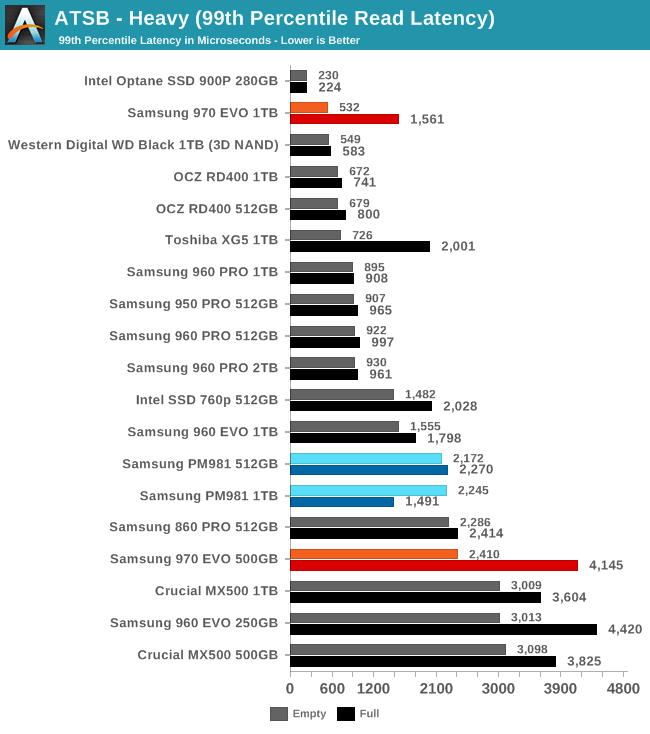

It is safe to say that the read latency rates (99th percentile) of both tested capacities of the 970 EVO are completely different for empty and full drives. The 500 GB model does not occupy top positions in terms of reading delay. But the 970 EVO with a capacity of 1TB would get a good mark if it were not for the WD Black with its characteristic minimum performance loss. The 99th percentile 970 EVO recording latency estimates are good, but not far from the competition, and the 500 GB model shows worse results than the 1 TB model or MLC drives with similar capacity.
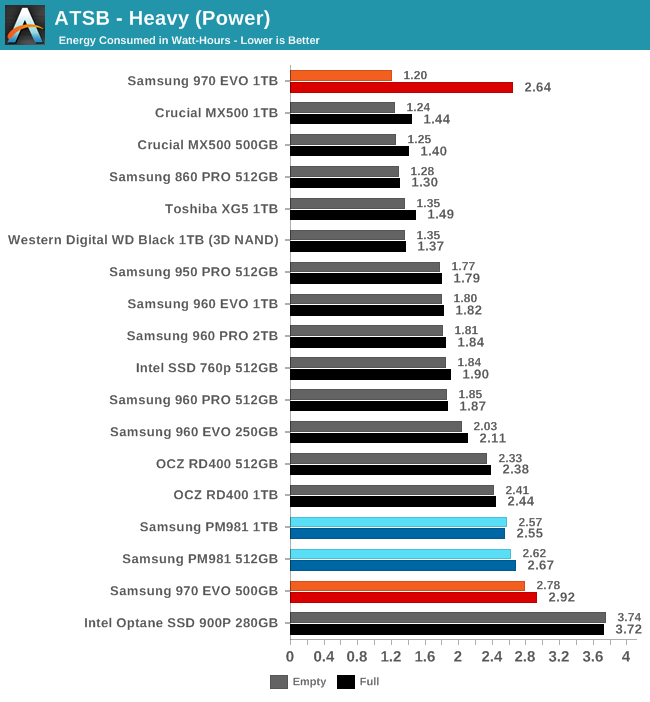
The 500 GB 970 EVO demonstrates the relatively poor energy efficiency of the Samsung Phoenix controller, in the 1 TB model, when running the test on an empty drive, the power consumption is equal to the consumption of good SATA drives.
Test drives AnandTech - Light
Our test for Light drives has relatively more consecutive sessions and a shorter queue depth than The Destroyer or Heavy, this is the shortest test. It is based mainly on applications that are not very dependent on the performance of the drive, so its results most likely reflect the launch time of applications and file downloads. This test can be considered as the sum of all small delays in everyday use, but when reducing downtime to 25 ms, it takes less than half an hour to complete it. Detailed information about the Light test can be found in the corresponding article on AnandTech. As in the case of the ATSB Heavy test, this test is run twice: on a drive that has been completely cleared, and after filling the drive with a sequential write.
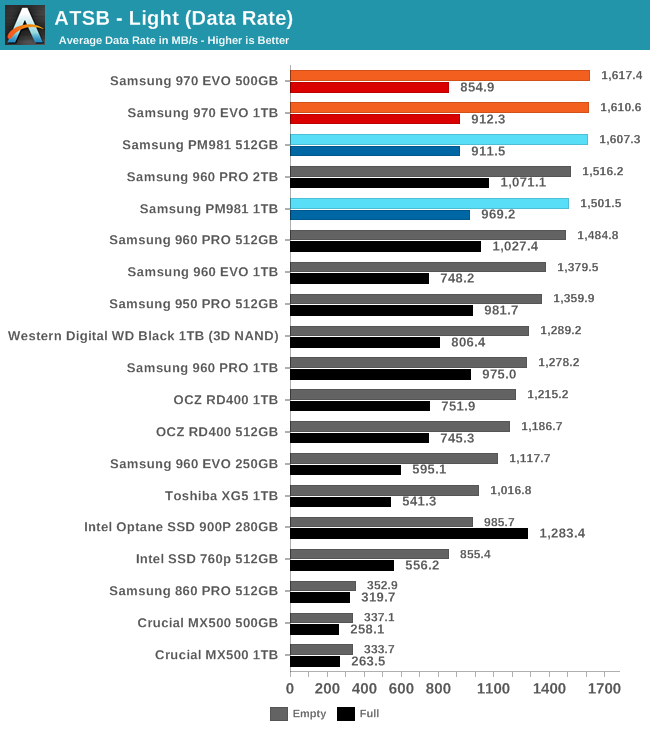
The peak performance of the Samsung 970 EVO in Light tests is a record, improved by 6% compared to the average data transfer rate of the Samsung 960 PRO. When the test is performed on a full drive, the 970 EVO loses more performance than most top drives, since the 970 EVO is one TLC-based drive in this segment.
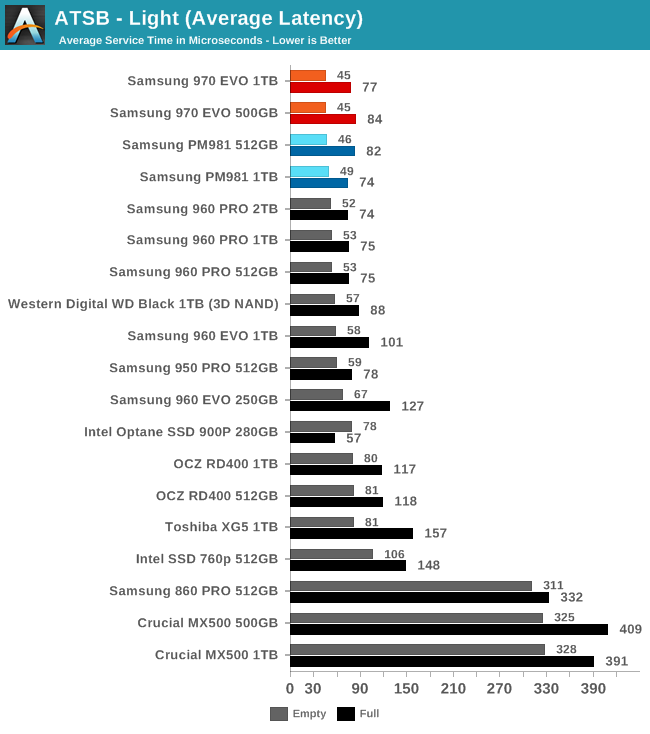
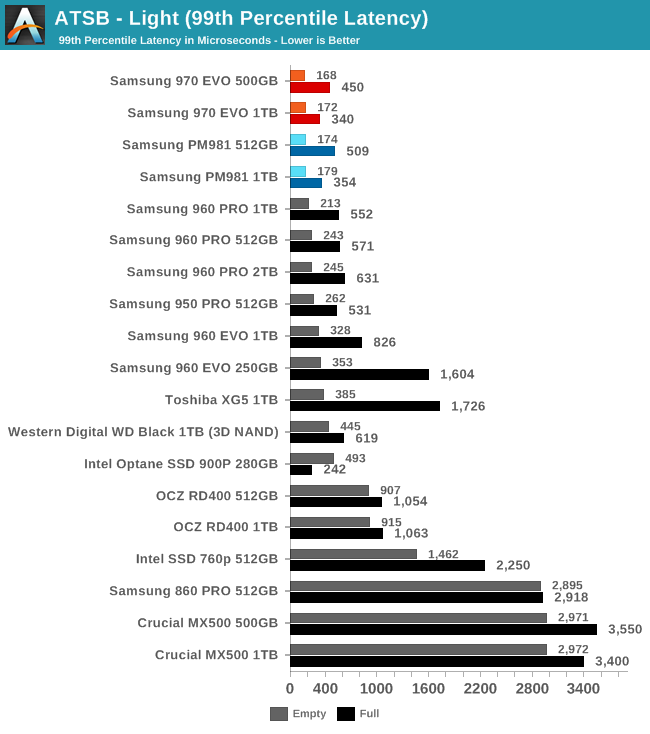
The results of the average latency of the 970 EVO and the 99th percentile of the delays during the testing of Light are the best, the 970 EVO has small improvements over the previous high-end solid-state drives from Samsung.
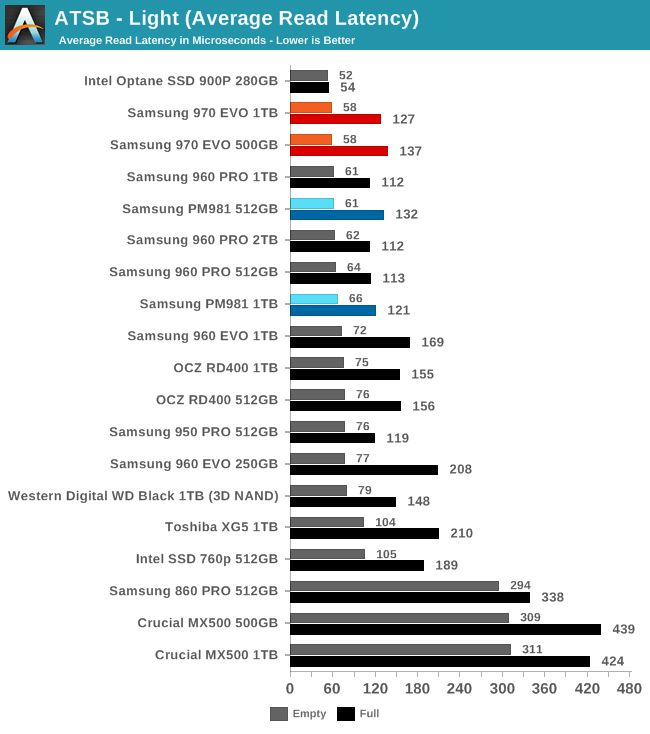
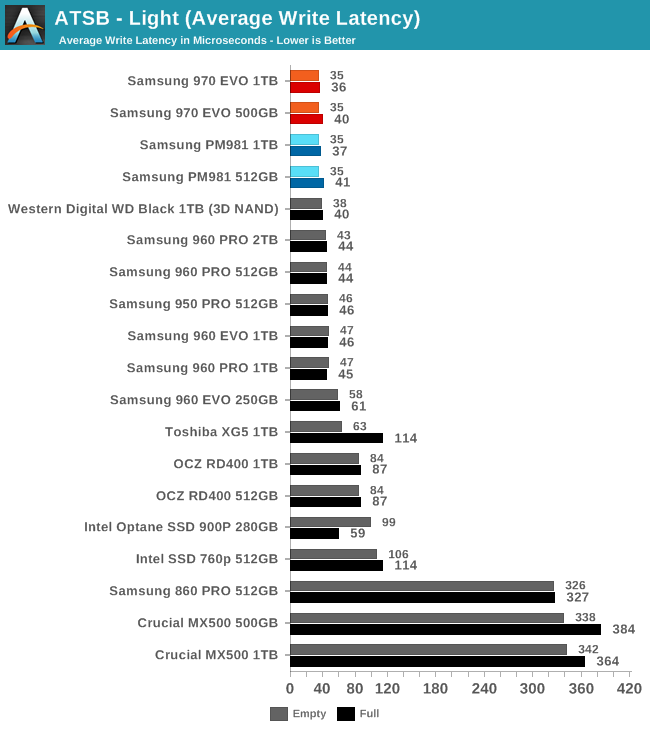
Samsung 970 EVO occupies a leading position among other solid-state drives according to the results of average read and write delays.
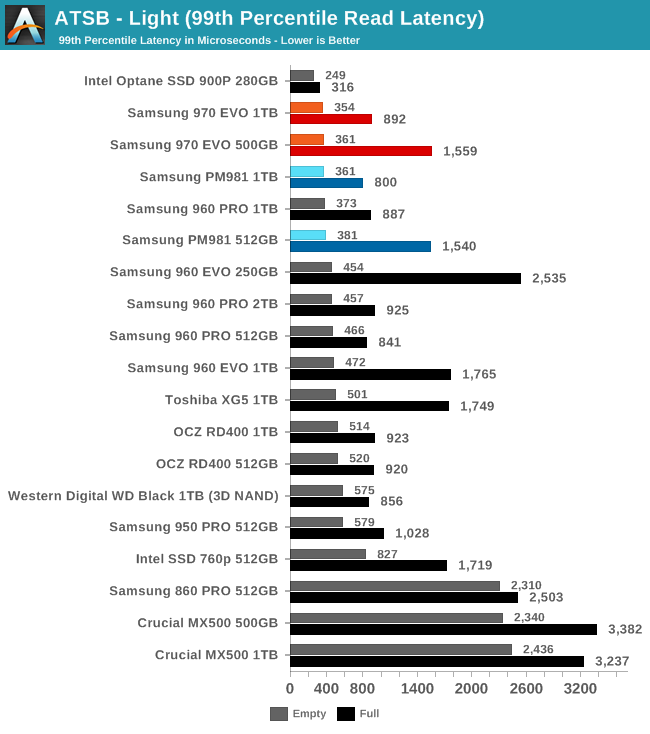
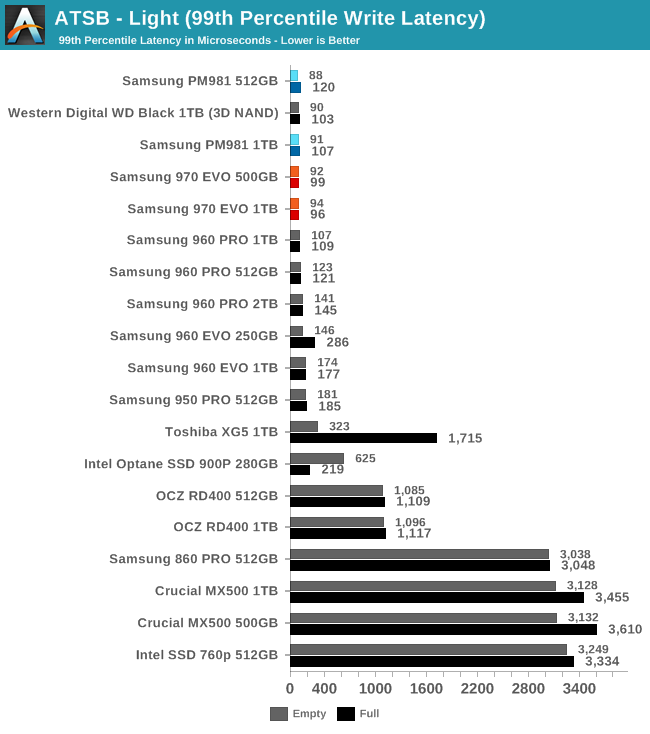
The Samsung 970 EVO is the first disc that demonstrates the write delay of the 99th percentile below 100 µs, regardless of whether the Light test runs on a full disc. The Samsung 970 EVO wins over the 960 EVO when testing a full drive, but there is something to improve in the 500 GB model.

The power consumption of the Samsung 970 EVO is slightly higher than that of the PM981, with the result that the 970 EVO takes up almost the last place among the solid-state drives based on flash memory. The power consumption of the 970 EVO, unlike the performance indicator, is completely independent of the test on a full or empty disk.
Random read test
Our first performance test for random reading uses very short bursts of operations, performed one at a time, without a queue. Drives get enough downtime between such “bursts” to provide a total cycle time of 20%, so thermal regulation is not possible. Each package has a size of 32 MB, read from random 4 kilobyte blocks, from a 16 GB disk range. The total amount of data is 1 GB.

With random read operations, the Samsung 970 EVO is the best product among TLC NAND flash memory devices. Intel SSD 760p still bypasses the Samsung 970 EVO by a few percent in this race.
Our reading performance test is similar to the test from the 2015 set: queue depths from 1 to 32 are checked, and the average performance and energy efficiency in QD1, QD2 and QD4 determine the main test scores. Each queue depth is checked one minute or 32 GB of transmitted data, which is faster. After checking the queue depth, the drive shuts down for up to one minute to cool down so that the accumulation of heat does not affect the greater queue depth. Separate read operations still work with 4kB blocks and cover a 64-gigabyte drive spacing.
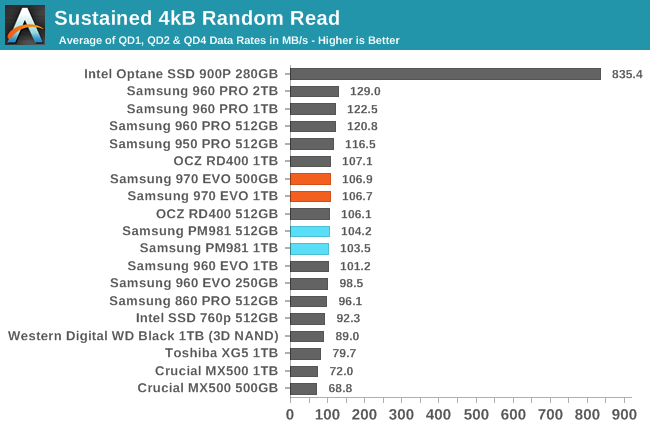
In the case of a longer test, the random reading performance indicator makes the Samsung 970 EVO the fastest TLC SSD, while Samsung’s MLC drives provide 20% better performance.

The Samsung 970 EVO and its fellow PM981 have the worst energy efficiency during random reading compared to any high-performance SSD. The 970 EVO consumes more than 2.5 watts, while Samsung’s drives of the previous generation of the middle class use less than 2 watts with very similar characteristics.
The scaling performance of the 970 EVO is almost identical to that of the 960 EVO, but the 970 EVO consumes more power during the random read test.
Performance with random write
The performance test of random data writing is planned similarly to the reading test, but each packet is now only 4 MB, and the total recording length is 128 MB. Random write operations of 4 KB are distributed over the 16-gigabyte range of the drive, and are issued one by one, without a queue.
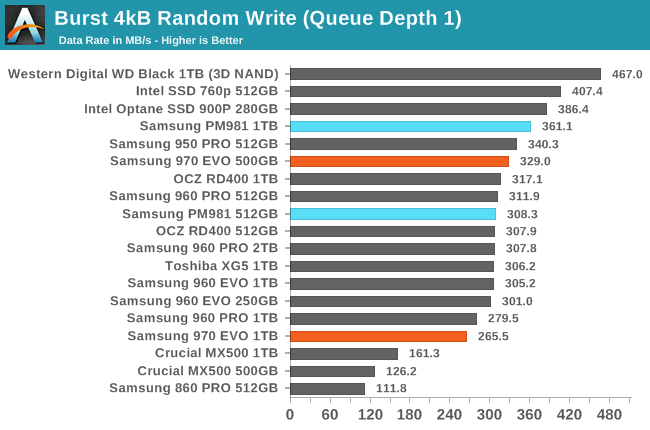
The performance of the Samsung 970 EVO with random recording is “sad” compared to the PM981, especially for the 1TB model. Meanwhile, Intel and WD drives are among the winners (due to fast SLC caches).
As with the read test, our test of a constant 4 KB random write lasts up to one minute or 32 GB per queue depth, spanning 64 GB of disk range. The drive also provides up to 1 minute of idle time between queue depths, which makes it possible to constantly overwrite caches and avoid overheating.

With a longer test for recording, 1TB PM981 showed maximum performance, 1TB 970 EVO about 12% slower, this result is on a par with the previous generation from Samsung. The 500 GB 970 EVO is slightly slower than its rival PM981.

The energy efficiency of the 970 EVO with random recording leaves much to be desired compared with not only the WD Black, but also the Toshiba XG5.
Performance with random write. Charts Performance with a random write 1TB 970 EVO - just over 1.5 GB / s with a queue depth of 8 and above. The 970 EVO with a capacity of 500 GB starts using the SLC cache and shows inconsistency after QD4. The 1TB PM981 boosts performance much faster than the 970 EVO, and reaches a maximum of 1.8 GB / s. The 512 GB PM981 behaved very similarly from the 970 EVO to 500 GB.
Sequential read performance
Our first sequential read performance test uses short bursts of 128 MB each, executed as operations in 128 KB blocks without queues. The test averages eight bursts of performance for a total of 1 GB of data read from a disk containing 16 GB of data. The drive idle time between each burst is sufficient for a total duty cycle of 20%.

Samsung PM981 set a new performance record with sequential recording, but the Samsung 970 EVO does not exactly match this indicator. Compared to the 960 EVO, the 970 EVO shows significantly better results, but still does not exceed the latest generation MLC drives.
1 32, QD1, QD2 QD4. 32 ( ), , 64 .

Samsung 970 EVO , Samsung PM981, Samsung . 970 EVO — TLC- , 1 960 PRO MLC 1TB.

1TB 970 EVO , - M.2, - , . 970 EVO 500 — .
Samsung 970 EVO — . WD Black Toshiba XG5, .
– . 128 128 , QD1, 1 , , 16 .
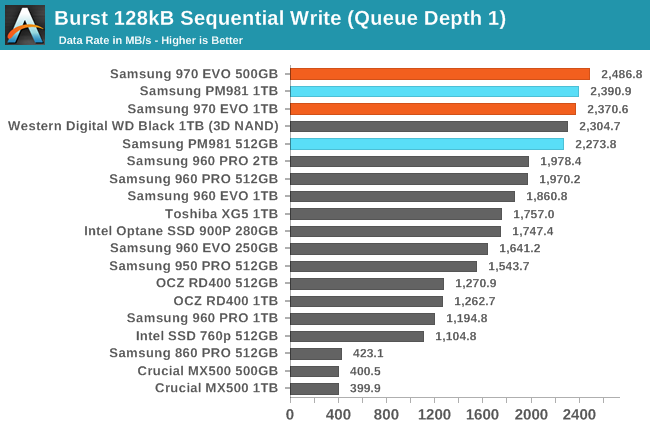
Samsung 970 EVO , 500 2,5 / . WD Black 970 EVO.
, . 1 32, 32 , , , . 64- .
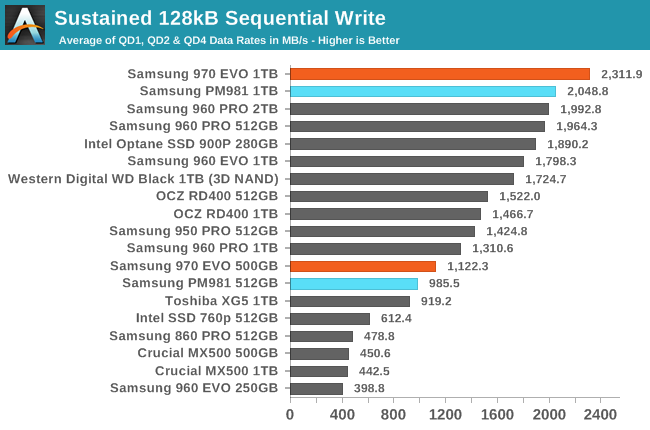
1TB 970 EVO , 1TB PM981. 500 - SLC PM981 512 .
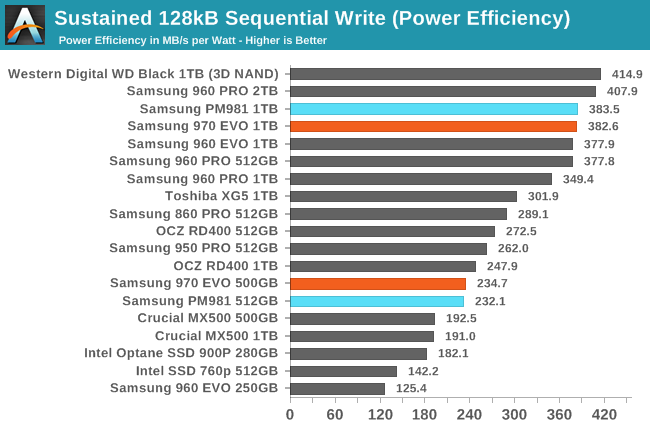
970 EVO PM981 — . 1 WD Black 960 PRO, 500 MLC .
970 EVO 1T QD1 PM981, .
, 10%. 1 , 32 . 4 64- . , 50%.

Samsung 970 EVO OEM PM981 I/O , 1 , 970 EVO 500 960 PRO MLC.
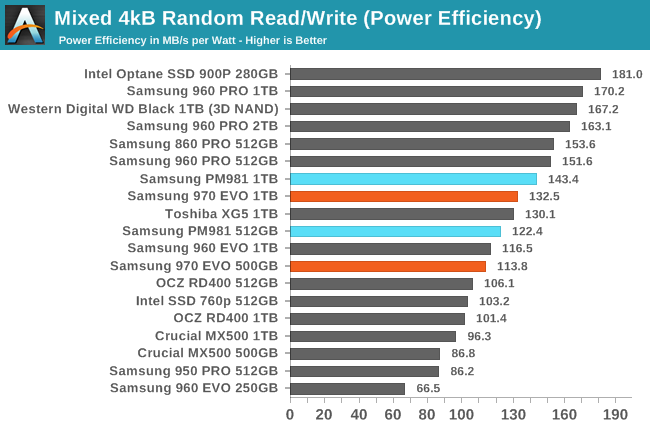 The energy efficiency of the Samsung 970 EVO exceeds many times the PM981, which is not the case for performance. The energy efficiency index of the best MLC drives seems almost unattainable for TLC drives, the exception is WD Black, this drive ranks third and shows a result 26% better than 970 EVO.
The energy efficiency of the Samsung 970 EVO exceeds many times the PM981, which is not the case for performance. The energy efficiency index of the best MLC drives seems almost unattainable for TLC drives, the exception is WD Black, this drive ranks third and shows a result 26% better than 970 EVO.Mixed random performance. Charts The performance of the Samsung 970 EVO at the beginning of the test slightly decreased (when adding a record), and began to increase during the rest of the test. The PM981 showed better performance with random writing in the final stages of the test and outperformed the Samsung 970 EVO.
Mixed sequential performance
Our mixed sequential read and write test, unlike the previous I / O test, performs successive calls of 128 KB in size (instead of 4 KB in random places), and also takes place at queue depth 1. The range of tested mixes has not changed, the timing and limits on data transfer is the same as described above.

The Samsung 970 EVO sets a record during a mixed sequential I / O test, with the 1 TB model leading the Intel Optane SSD and the WD Black. Model 500 GB is much slower, but it works well. Both models bypass the PM981.
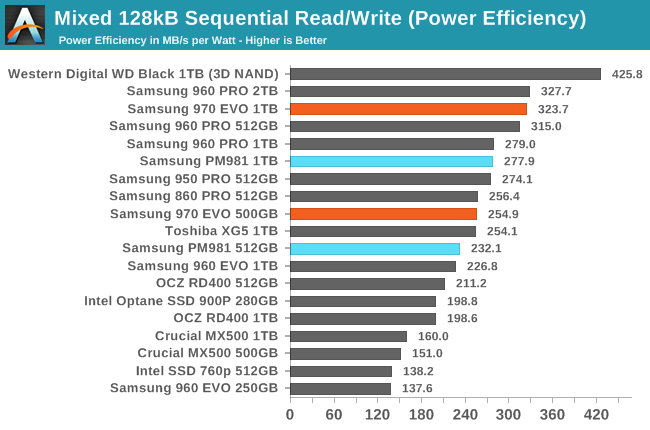
1TB Samsung 970 EVO ranks second in energy efficiency with a mixed sequential I / O test, the first place on the right of WD Black. The increased performance of the 970 EVO compared to PM981 is equal to increased efficiency.
Mixed consistent performance. Charts The performance of the Samsung 970 EVO with mixed sequential I / O testing varies. The 1TB 970 EVO demonstrated a performance boost at the end of the test.
Power management
In the real world, home drive load mode leaves SSDs inactive most of the time. This means that the active power measurements presented earlier in this review show only part of how to determine the quality of the drive when using battery power. When lightly used, the energy efficiency of an SSD is determined by how much it can save electricity in standby mode.
For many solid-state drives NVMe is not unimportant such a figure as power management. It turns out that M.2 SSD accumulate a lot of energy in a very small space. Often, drives operate at high temperatures and with poor cooling, for example, they are placed under a graphics processor on the motherboard in a desktop PC or “plow” in a poorly ventilated laptop.

The Samsung 970 EVO, which supports NVMe 1.3, is superior to the PM981 and 960, which supports NVMe 1.2. The 970 EVO supports Host Controlled Thermal Management. The 970 EVO does not perform background tasks, such as garbage collection, when it is in standby mode.

Measurement of power at idle
SATA SSDs are tested when SATA power management is turned off to measure their active standby consumption, and further evaluate deep standby consumption and wake up delay. Our test bench, like any desktop system, cannot launch the deepest inactivity state of DevSleep (the lowest power consumption mode).
Idle consumption management for NVMe SSDs is much more complicated than for SATA SSDs. NVMe SSDs have different idle states, they differ from each other in power consumption and delays that occur when a component returns to its active state. The WD Black drive supports APST (Standalone Power State Change) technology.
We measure inactivity consumption in two ways. Active standby is a typical desktop PC that does not use any of the advanced power saving features of PCIe or NVMe, and the drive is immediately ready for processing new commands. Standby power consumption is measured with Power Status L1.2 PCIe powered on and NVMe APST enabled.
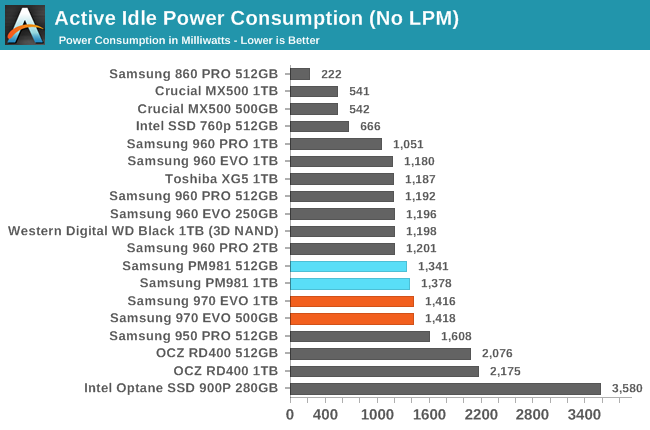
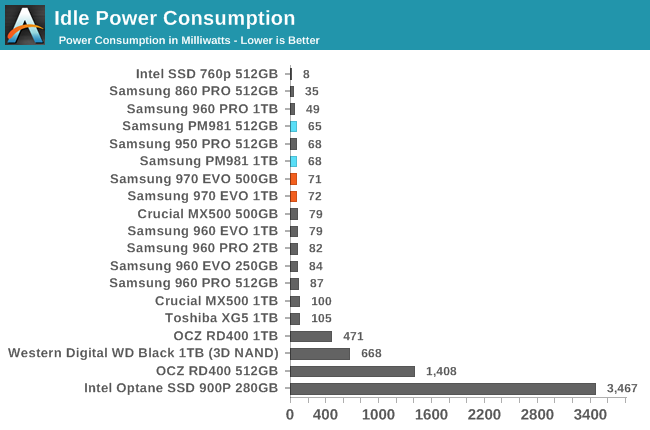
Active idle power of the 970 EVO is about 20% higher than previous generations of Samsung drives, but the power consumption while waiting is about the same as that of most other high-end NVMe drives.

The wake-up latency of the 970 EVO is more than two times higher than that of its predecessors, and significantly higher than that of the Samsung PM981. This 970 EVO delay is ~ 14 ms, thus going beyond the 8 ms required for the Samsung PM981 drive to “exit” from the deepest sleep state.
In conclusion
The difference between the Samsung 970 EVO and Samsung’s earlier NVMe drives (for retail sales) has nothing to do with performance or power consumption. Direct competitor 970 EVO - Western Digital WD Black SSD second generation. This year, Samsung faces two challenges: to improve its already high-end NVMe SSDs, and also to maintain its leadership position. As you can see, competitors are not asleep and come on the heels. Samsung's 3D-NAND is no longer a unique product and provides an advantage in the race for the leading position. We finally met other NVMe controllers, which also achieve a high level of performance paired with a suitable NAND.
Samsung 970 EVO will compete with the latest top-end SSD (consumer) of other brands. Unlike previous years, Samsung does not always occupy top positions on the performance graph. Despite this, we do not expect a product to appear on the market this year, which can completely surpass the 970 EVO. In most cases, the performance of the 970 EVO disappointed us compared to the performance of the OEM-drive PM981.

The Intel SSD 750 was the first drive to demonstrate significant performance advantages in NVMe. Soon it was overshadowed by the Samsung 950 PRO, which showed much better performance in the “real world” due to better optimization of consumer loads. The 960 PRO and 960 EVO brought the performance to a higher level, thanks to the significantly improved second generation NVMe controller. 970 EVO offers another generation - the generation of new controllers and NAND. We are still limited by the PCIe 3 x 4 bandwidth with sequential reads. The density of Samsung's 3D-NAND is increasing, but this does not add to a significant improvement in performance or energy efficiency. All this forces Samsung to make compromises such as the EVO 970, sacrificing energy efficiency for the benefit of a slight increase in performance. Almost every consumer will be able to say that the 960 PRO and 960 EVO have already been known as fast enough drives. In short, the 970 EVO did not cause a wow effect. The new Western Digital WD Black is not as fast as Samsung drives, but its magical energy efficiency is a unique advantage that makes it stand out in the “elite” market segment.
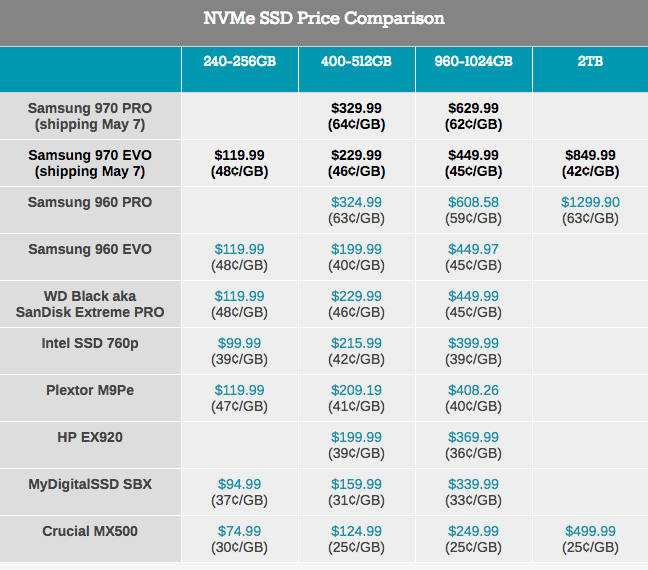
Since the performance of solid-state high-end drives is no longer growing at a crazy pace, consumers will think seven times whether they need a high-end drive at all. The NVMe SSD market is no longer divided into Samsung high-end drives and unsuccessful attempts by other manufacturers. There is already a lower-end segment of NVMe SSD drives: they are closer to SSD SATA, but with much better performance. Consumers can find drives fast enough and at the same time cheaper than the 970 EVO.
Options 2 TB NVMe is not so much, and agree that to buy 970 EVO for 849 dollars is still more profitable than the 960 PRO for 1299 dollars. The options with a capacity of up to 1TB - for every taste and color. It seems that the recommended retail price of most of them is at or slightly below 970 EVO.
Western Digital WD Black currently complies with the pricing policy of 970 EVO, it is possible that the price of WD may decline at any time. In pursuit of a low price, NVMe drives are stamped with performance not better than that of good SATA. Drives, such as the Intel 760p, still show excellent results, and even the low-cost NVMe MyDigitalSSD SBX, which is 20–30% cheaper than the 970 EVO, outperforms any SATA. Today's market offers a huge selection of NVMe, and the Samsung 970 EVO managed to take its position among the leaders.
Thank you for staying with us. Do you like our articles? Want to see more interesting materials? Support us by placing an order or recommending to friends,
30% discount for Habr users on a unique analogue of the entry-level servers that we invented for you: The whole truth about VPS (KVM) E5-2650 v4 (6 Cores) 10GB DDR4 240GB SSD 1Gbps from $ 20 or how to share the server? (Options are available with RAID1 and RAID10, up to 24 cores and up to 40GB DDR4).
Dell R730xd 2 times cheaper? Only we have
2 x Intel Dodeca-Core Xeon E5-2650v4 128GB DDR4 6x480GB SSD 1Gbps 100 TV from $ 249 in the Netherlands and the USA! Read about
How to build an infrastructure building. class c using servers Dell R730xd E5-2650 v4 worth 9000 euros for a penny?